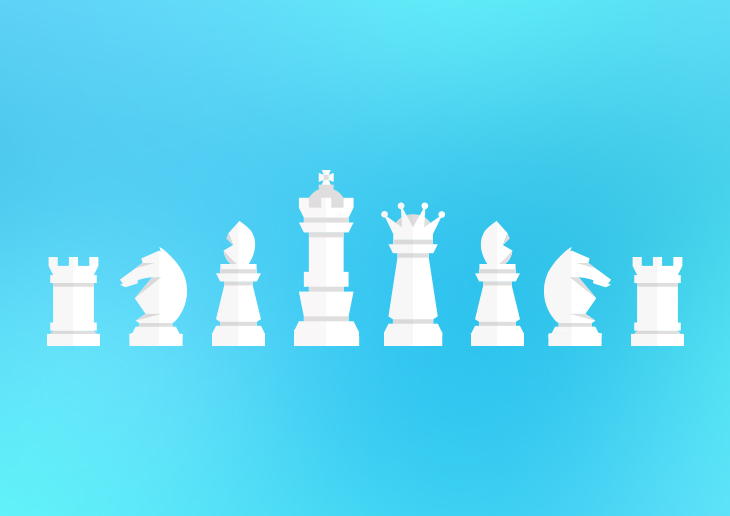How Chess Makes Me A Better Designer
Billy French, Former Senior Designer
Article Category:
Posted on

Our industry hinges on great ideas. And, while the design community is great at talking about technique, I don’t often find advice on critical thinking and problem solving skills—the very skills that, I find, help lead to great ideas. It’s possible that I’ve noticed this gap because, besides being a designer, I’m also an avid chess player. For me, chess is a powerful exercise in creative strategy when faced with nearly infinite permutations. As such, chess makes me a better designer.
First, a word about chess itself. According to neurobiology professor Susan R. Barry in Psychology Today, chess changes the brain in a surprising way:
Why would an area of the brain devoted to the recognition of faces be activated in chess experts when they view a chess game? To recognize a face, we need to see more than the eyes, nose, and mouth. We must analyze the spatial relationships between all these features. Similarly, an understanding of the spatial relationships between game pieces is crucial for winning at chess.
In other words, the area of the brain responsible for facial recognition becomes active during a chess match. That’s because chess, like facial feature recognition, engages our brains to analyze spatial relationships to communicate information to our brain.
Spatial recognition is used everyday when it comes to layout and composition—and while I completely agree that there’s an incredible amount of intuition happening during the design process, we wouldn’t have the ability to process those thoughts into tangible deliverables without some good, old-fashioned brain power.
More specifically, though, how is chess like design? Here are some examples.
The Art of Chess
Future-proofing
How does moving piece X now affect Y later? Chess teaches future-proofing in a unique way. Like setting up your pieces for an excellent defense while still putting pressure on your opponent, being able to provide smart design choices early on is proactive and beneficial to everyone on your projects. For example, designing a site with mobile in mind will make responsive design easier and less burdensome on your development team, leading to better use of time and budget for the project.
Near-infinite possibilities
To this day, chess has not been “solved,” meaning there is no guaranteed way to win based on a standard set of moves. It’s an exercise in creative problem solving at its finest! How players approach a chess game is going to be unique every time. Similarly, no two designers will tackle a visual problem the same way. Design is extremely subjective and, oftentimes, open to interpretation, with varying strategies depending on the problem you’re trying to solve.
Building resilience
According to Brooklyn-based chess teacher Elizabeth Spiegel, chess “teaches a certain resilience. No matter how good you get as a chess player, you’re going to get in bad positions. And you have to deal with them, you can’t just give up when you have them.”
This happens all the time in the design process. You’re going to face opposition down the road and part of the job is dealing with struggle. Mindy has said it best: “We need to deal with those failures the right way so we can continue to push boundaries.”
Strengthening concentration
In a game like chess, you’re forced to constantly survey the situation. Several actions are taking place all at once during a chess game, generally against the clock too:
- Predicting your opponent’s future moves
- Responding to your opponent’s last move
- Planning your future attacks / defenses
- Solving the main objective: getting your opponent into checkmate.
Design is similarly orchestrated. A designer’s ability to predict how the client and fellow team mates will react to the work is crucial for delivering an effective end-product. There’s the same kind of back and forth too—revisions are based on client reactions, and it all has to be done under time constraints to meet the deadlines. Strengthening your ability to concentrate will make these goals and tasks much easier to hit on time at higher levels of quality.
It’s all about hierarchy
French chess master Andre Philidor once said: “Pawns are the soul of chess.” Pawns are relatively immobile pieces that dictate the movement of other pieces on the board. Their survival provides immense support in the game of chess, and building a strong pawn structure is paramount for protecting your pieces. This is a hierarchy skill - something designers use everyday in their work (typographic, color, size…). Both design and chess require the ability to identify patterns and weaknesses—and much like the pawns of a chess game, design hierarchy provides a foundation for successful design.
And hey, chess is fun!
Like design, chess can be an extremely fun and fulfilling on its own!
Resources to get you started playing chess:
Chess.com provides a rating system and gets you playing people all over the world.
ChessCentral is a great, online beginner's guide to chess strategy
Brooklyn Castle is a fantastic documentary on chess in schools.